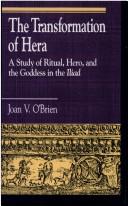| Listing 1 - 10 of 21 | << page >> |
Sort by
|
Book
ISBN: 0691644683 1400869765 Year: 2015 Publisher: Princeton : Princeton University Press
Abstract | Keywords | Export | Availability | Bookmark
 Loading...
Loading...Choose an application
- Reference Manager
- EndNote
- RefWorks (Direct export to RefWorks)
What did Zeus mean to the Greeks? And who was Hera, united with Zeus historically and archetypally as if they were a human pair? C. Kerenyi fills a gap in our knowledge of the religious history of Europe by responding to these questions. Examining the word Zeus and its Greek synonyms theos and daimon, the author traces the origins of Greek religion in the Minoan-Mycenacan civilization. He shows how Homer's view of the gods decisively shaped the literary and artistic tradition of Greek divine mythology. The emergence of the Olympian family is seen as the expression of a humane Zeus cult determ
Book
ISBN: 9789516534964 9516534961 Year: 2023 Publisher: Helsinki : Societas Scientiarum Fennica, The Finnish Society of Sciences and Letters,
Abstract | Keywords | Export | Availability | Bookmark
 Loading...
Loading...Choose an application
- Reference Manager
- EndNote
- RefWorks (Direct export to RefWorks)
The subject of this work is the cult of goddess Hera in the Greek colony of Poseidonia, in Southern Italy. The work focuses on the process through which the local Italic Lucanians preserved and continued the cult after they had taken control of the city from the Greeks sometime between 420 and 410 BCE. Archaeological material, such as votive clay figurines, and the topographical and architectural features of several cultic places were employed as the primary data sources. By combining evidence from the iconographic typologies of the clay figurines and the topography and the architecture of both Greek and Lucanian sanctuaries, this work postulates that the absorption and the reshaping of the cult of Hera was a natural process for the Lucanians, since they had long had deities who shared the same attributes as Hera in their own religion. Scholars have studied the cult of Hera in Poseidonia almost exclusively as a Greek phenomenon. The Lucanians have been considered only as adopters of the cult following a unidirectional Hellenisation process. Older research has dismissed or underestimated the influence of the Lucanians on the cult and their decisive role in preserving it until the Roman Imperial period. If one dismisses a sort of pervasive Hellenisation as the reason behind the appropriation of the cult by the Lucanians, then the causes may lay in the nature of Poseidoniate Hera herself, and in specific features of the Lucanian religion. The Hera of Poseidonia had her roots in that particular Hera worshipped in the Argolid in mainland Greece. This Argive Hera had pre-Homeric features, according to which she was the patron goddess of vegetation and fertility, with a strong chthonic character. The Achaean cities of Magna Graecia, including Poseidonia, held Hera as one of their main deities. Archaeological evidence suggests that her cult in Poseidonia continued and thrived when the Lucanians, a non-Greek population, came into control of the city. In fact, most of the votive gifts dedicated to Hera in Poseidonia are dated to the Lucanian period. The Greeks and the Lucanians created a multicultural society, which was reflected by their shared religious worship of the goddess. This process was facilitated by the fact that several Lucanian female deities, and particularly Mefitis, the main goddess of Lucanian religion, shared similar attributes with Poseidoniate Hera. Comparing the votive figurines recovered from Paestan sanctuaries dedicated to Hera and the topographical features of her sanctuaries to the main features of Lucanian cultic places, and to the iconography of votive gifts dedicated in Lucanian sanctuaries, this research suggests that widely shared religious similarities enabled the continuation of the cult of Hera in Poseidonia/Paestum. In addition, by taking into consideration Lucanian religion and the architectonic and topographic planning of its shrines, it is possible to suggest possible solutions to several problematic issues related to the cult of Hera in the Lucanian period, such as the changes in the iconography of the goddess in votive figurines, and certain architectonic features introduced in the Lucanian period that are reminiscent of Lucanian construction practices. Concerning ritual practices, the increase in common ritual dining was the result of the arrival of chthonic cults in Lucanian Paestum, or at least the addition of chthonic aspects typical of the agrarian and chthonic cults of the Lucanian inland to existing Greek cults. This was true for the cult of Hera as well. The archaeological evidence suggests the arrival of Lucanian rural chthonic religious practices connected with common ritual dining in the form of bone finds related to chthonic cults (dogs, cockerels), the development of peculiar forms of incense burners, and the presence of sacrificial pits and water channels associated with altars. The cult of Hera thrived throughout the Greek and Lucanian periods until the foundation of the Roman colony of Paestum in 273 BCE, when it was incorporated into the cult of the Capitoline Triad and gradually lost its primacy to cults favoured by the new Roman colonists.
Héra, --- Italy --- Religious life and customs. --- Temples --- Multiculturalism --- Religious aspects --- Hera --- Cult --- Art.
Map
Year: 2014 Publisher: [Reston, Va.] : U.S. Geological Survey,
Abstract | Keywords | Export | Availability | Bookmark
 Loading...
Loading...Choose an application
- Reference Manager
- EndNote
- RefWorks (Direct export to RefWorks)
Geology --- Herat Mineral District (Afghanistan) --- Herāt (Afghanistan : Province) --- Afghanistan
Book
ISBN: 9781841716091 184171609X Year: 2004 Volume: 1249 Publisher: Oxford : Archaeopress,
Abstract | Keywords | Export | Availability | Bookmark
 Loading...
Loading...Choose an application
- Reference Manager
- EndNote
- RefWorks (Direct export to RefWorks)
Hera (Greek deity) --- Votive offerings --- Temples --- Héra (Divinité grecque) --- Ex-voto --- Cult --- Art --- Culte --- Excavations (Archaeology) --- Cult. --- Héra (Divinité grecque) --- Hera (Greek deity) - Cult. --- Temples - Greece. --- Temples - Turkey. --- Votive offerings - Greece --- Votive offerings - Turkey. --- Excavations (Archaeology) - Aegean Sea Region

ISBN: 0847678083 Year: 1993 Publisher: Totowa Rowman & Littlefield
Abstract | Keywords | Export | Availability | Bookmark
 Loading...
Loading...Choose an application
- Reference Manager
- EndNote
- RefWorks (Direct export to RefWorks)
Epic poetry, Greek --- Goddesses, Greek, in literature --- Hera (Greek deity) in literature --- Hera (Greek deity) --- Heroes in literature --- Ritual in literature --- History and criticism --- Cult --- Homer.

ISBN: 0292794835 0292717253 Year: 2007 Publisher: Austin : University of Texas Press,
Abstract | Keywords | Export | Availability | Bookmark
 Loading...
Loading...Choose an application
- Reference Manager
- EndNote
- RefWorks (Direct export to RefWorks)
Praised by his many admirers as a "courageous and fearless" defender of human rights, Heráclito Fontoura Sobral Pinto (1893-1991) was the most consistently forceful opponent of the regime of Brazilian dictator Getúlio Vargas. John W. F. Dulles chronicled Sobral's battles with the Vargas government in Sobral Pinto, "The Conscience of Brazil": Leading the Attack against Vargas (1930-1945), which History: Reviews of New Books called "a must-read for anyone wanting to understand twentieth-century Brazil." In this second and final volume of his biography of Sobral Pinto, Professor Dulles completes the story of the fiery crusader's fight for democracy, morality, and justice, particularly for the downtrodden. Drawing on Sobral's vast correspondence, Dulles offers an extensive account of Sobral's opposition to the military regime that ruled Brazil from 1964 to 1985. He describes how Sobral Pinto defended those who had been politically influential before April, 1964, as well as other victims of the regime, including Communists, once-powerful labor leaders, priests, militant journalists, and students. Because Sobral Pinto participated in so many of the struggles against the military regime, his experiences provide vivid new insights into this important period in recent Brazilian history. They also shed light on developments in the Catholic Church (Sobral, a devout Catholic, vigorously opposed liberation theology), as well as on Sobral's key role in preserving Brazil's commission for defending human rights.
Lawyers --- Pinto, Heráclito Sobral, --- Brazil --- Politics and government --- Advocates --- Attorneys --- Bar --- Barristers --- Jurists --- Legal profession --- Solicitors --- Persons --- Representation in administrative proceedings --- Legal status, laws, etc. --- Sobral Pinto, Heráclito, --- Pinto, Sobral, --- Fontoura Sobral Pinto, Heráclito, --- Sobral Pinto, --- Sobral Pinto, Heráclito
Map
Year: 2014 Publisher: [Reston, Va.] : U.S. Geological Survey,
Abstract | Keywords | Export | Availability | Bookmark
 Loading...
Loading...Choose an application
- Reference Manager
- EndNote
- RefWorks (Direct export to RefWorks)
Geology --- Geology --- Geology. --- Herat Mineral District (Afghanistan) --- Herāt (Afghanistan : Province) --- Afghanistan
Dissertation
Year: 2020 Publisher: Liège Université de Liège (ULiège)
Abstract | Keywords | Export | Availability | Bookmark
 Loading...
Loading...Choose an application
- Reference Manager
- EndNote
- RefWorks (Direct export to RefWorks)
Up to date, no dedicated gravimeter instrument has been included on any probe to a small planetary body. The aim of the GRASS (Gravimeter for Small Solar System bodies) project at the Royal Observatory of Belgium is to fill this gap by developing an instrument capable of precise gravity vector measurement from the surface, in small gravity fields of 10^-3 - 10^-5 m/s^2. In the near future, the GRASS gravimeter is proposed to be a part of the HERA mission to the binary asteroid system Didymos. This work addresses the development of a model aiming to simulate the measurement of the gravimeter after landing on Didymos' secondary body, and an initial evaluation of the measurement feasibility and accuracy using the developed model.
Book
Year: 1970 Publisher: Göteborg : P. Aström,
Abstract | Keywords | Export | Availability | Bookmark
 Loading...
Loading...Choose an application
- Reference Manager
- EndNote
- RefWorks (Direct export to RefWorks)
Sculpture, Greek --- Pediments --- Sculpture grecque --- Frontons --- Olympia (Greece : Ancient sanctuary) --- Temple of Zeus (Olympia, Greece) --- Temple of Hera (Olympia, Greece)
Book
ISBN: 0807057959 Year: 1971 Publisher: Boston, MA : Beacon Press,
Abstract | Keywords | Export | Availability | Bookmark
 Loading...
Loading...Choose an application
- Reference Manager
- EndNote
- RefWorks (Direct export to RefWorks)
Comparative religion --- Sociology of the family. Sociology of sexuality --- Antiquity --- Greece --- History of ancient Greece --- Thematology --- Classical Greek literature --- Mythologie grecque --- Hera, deesse grecque --- Family --- Mythology --- Book --- Relationship mother and son
| Listing 1 - 10 of 21 | << page >> |
Sort by
|

 Search
Search Feedback
Feedback About UniCat
About UniCat  Help
Help News
News